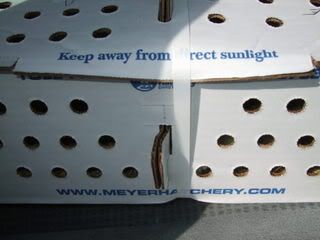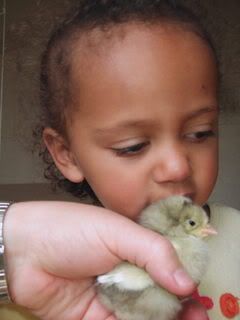Look What Came in the Mail!
We got a phone call from the local Post Office early Thurday morning. "Your package is here, please come pick it up RIGHT AWAY!"
We've been waiting for this.

There sure are a lot of holes in that box! (and it sure is noisy!)

Welcome home, little ones!

You might be wondering about whether or not it's humane to mail chicks via the postal service. Actually, baby chicks aborb the 'yolk sac' right before they hatch, and the nutrients from that provide them with everything they need for about three days. According to the box, these hatched at 5am on Monday morning. We picked them up on Thursday morning, and they were all really healthy, active and pretty noisy!
Back at home, we had everything set up. Plenty of food and water, plenty of space, a light to keep them warm (newborn chicks like it really warm). You can see from the picture that they were thirsty - some of them are clustering in the little pans of water!

We haven't raised heavy breed chicks in a while - I had forgotten how big they are! Those wee pans of water were not cuttin' it, so I measured and discovered they are already big enough to drink from a full size waterer! We switched things around today, and now they have a 3 gallon waterer, and 3 pans of feed.
When they lose their fuzz, all of them will be white. The yellow ones have a different purpose from the smoky ones, so I have to figure out a way to mark them before they're just a bunch of white-feathered teenage birds.

The ones with smoky fuzz are White Plymouth Rocks, and they're all females. They are a heavy breed that lays big brown eggs. When you breed them with a Cornish rooster, you get chicks like those little yellow ones.
Those little yellow ones are broilers, and all roosters. In six to eight weeks, they will go into our freezer. A lot of people don't like to think about this, I know. But if you eat chicken at all, you're part of this process, whether you know the birds personally or not. When we raise our own birds, we know that they've been well fed, they've had comfortable housing and lots of time outdoors in fresh air and sunshine. We treat them humanely and respectfully, and when their time comes, we make sure they don't suffer. But right now, they're awfully darned cute, aren't they?

From here on out we hope to breed our own broilers. We have some White Laced Red Cornish Roosters that are about 8 or 9 weeks old, so once the White Rocks reach maturity, we'll be able to cross breed them and we should get a pretty nice broiler from that pairing. It'll be a while, though...stay tuned if you're interested in how this works out!
We've been waiting for this.

There sure are a lot of holes in that box! (and it sure is noisy!)

Welcome home, little ones!

You might be wondering about whether or not it's humane to mail chicks via the postal service. Actually, baby chicks aborb the 'yolk sac' right before they hatch, and the nutrients from that provide them with everything they need for about three days. According to the box, these hatched at 5am on Monday morning. We picked them up on Thursday morning, and they were all really healthy, active and pretty noisy!
Back at home, we had everything set up. Plenty of food and water, plenty of space, a light to keep them warm (newborn chicks like it really warm). You can see from the picture that they were thirsty - some of them are clustering in the little pans of water!

We haven't raised heavy breed chicks in a while - I had forgotten how big they are! Those wee pans of water were not cuttin' it, so I measured and discovered they are already big enough to drink from a full size waterer! We switched things around today, and now they have a 3 gallon waterer, and 3 pans of feed.
When they lose their fuzz, all of them will be white. The yellow ones have a different purpose from the smoky ones, so I have to figure out a way to mark them before they're just a bunch of white-feathered teenage birds.

The ones with smoky fuzz are White Plymouth Rocks, and they're all females. They are a heavy breed that lays big brown eggs. When you breed them with a Cornish rooster, you get chicks like those little yellow ones.
Those little yellow ones are broilers, and all roosters. In six to eight weeks, they will go into our freezer. A lot of people don't like to think about this, I know. But if you eat chicken at all, you're part of this process, whether you know the birds personally or not. When we raise our own birds, we know that they've been well fed, they've had comfortable housing and lots of time outdoors in fresh air and sunshine. We treat them humanely and respectfully, and when their time comes, we make sure they don't suffer. But right now, they're awfully darned cute, aren't they?

From here on out we hope to breed our own broilers. We have some White Laced Red Cornish Roosters that are about 8 or 9 weeks old, so once the White Rocks reach maturity, we'll be able to cross breed them and we should get a pretty nice broiler from that pairing. It'll be a while, though...stay tuned if you're interested in how this works out!

Comments
D.
I do admire folks who do though, and if I ever find a farmer here that would do it for me, I would gladly go that route!
hugs
mel
They are SO CUTE!!
I know what you mean, mel, and believe me, that first year I was afraid I'd have an awful lot of pets!
gill, we ordered 25 (the minimum) and they sent 26 (most every hatchery will send one spare). Total with shipping was about $48. Feed is getting really expensive - the gamebird/turkey grower that we use for our babies (it's not medicated and we prefer that) is up to about $14 for 50 pounds.
You can buy whole chickens on sale at the supermarket for less than the cost of raising birds at home, but really, these should be compared to the free-range, all natural birds you'd pick up at a health food store. I intend to figure my cost per bird, but I can't run the numbers until we're all done raising them. I'll post about it once I know, OK? (I'm curious about what it will cost us too!)